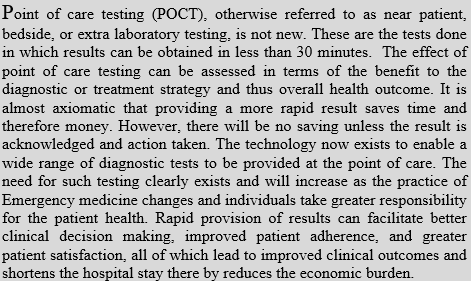A Clinical review. Point of care testing (POCT)-A boon to Emergency Department.
Abstract
Point of care testing (POCT), otherwise referred to as near patient, bedside, or extra laboratory testing, is not new. These are the tests done in which results can be obtained in less than 30 minutes. The effect of point of care testing can be assessed in terms of the benefit to the diagnostic or treatment strategy and thus overall health outcome.5
It is almost axiomatic that providing a more rapid result saves time and therefore money. However, there will be no saving unless the result is acknowledged and action taken. The technology now exists to enable a wide range of diagnostic tests to be provided at the point of care. The need for such testing clearly exists and will increase as the practice of Emergency medicine changes and individuals take greater responsibility for the patient health. Rapid provision of results can facilitate better clinical decision making, improved patient adherence, and greater patient satisfaction, all of which lead to improved clinical outcomes and shortens the hospital stay there by reduces the economic burden.
Downloads
References
Price CP, Hicks JM, eds. Point-of-care testing. Washington: AACC Press, 1999.
England JM, Hyde K, Lewis SM, Mackie IJ, Rowan RM, et al. Guidelines for near-patient testing: haematology. Clin Lab Haem 1995;17:300-9.
Crook MA. Near patient testing and pathology in the new millennium. J Clin Pathol 2000;53:27-30.
Burnett D, Freedman D. Near-patient testing: the management issues. Health Services Management. 1994:3:10-2.
Price CP. Evidence based laboratory medicine: supporting decision mak- ing. Clin Chem 2000;46:1041-50.
Kendall J, Reeves B, Clancy M. Point of care testing: randomised, control- led trial of clinical outcome. BMJ 1998;316:1052-7.
Scott MG, Faster is better-its rarely that simple: Clin Chem 2000;46:441-2
Hobbs FDR, Delaney BC, Fitzmaurice DA, Wilson S, Hyde CJ, Thorpe GH, et al. A review of near patient testing in primary care. Health Technol Assess 1997;1:1-230.
Diabetes Control and Complications Trial Research Group. The effect of intensive treatment of diabetes on the development and progression of long-term complications in insulin-dependent diabetes mellitus. N Engl J Med 1993;329:977-86.
UKPDS Group. Intensive blood glucose control with sulphonylureas or insulin compared with conventional treatment and risk of complications in patients with type 2 diabetes (UKPDS 33). Lancet 1998;352:837-53.
Gallichan M. Self-monitoring of glucose by people with diabetes: evidence based practice. BMJ 997;314:964.
Langer O, Rodriguez DA, Xenakis EM, McFarland MB, Berkus, MD, Arrendondo F, et al. Intensified versus conventional management of gestational diabetes. Am J Obstet Gynecol 1994;170:1036-47.
Grieve R, Beech R, Vincent J, Mazurkiewicz, J. Near patient testing in diabetes clinics: appraising the costs and outcomes. Health Technol Assess 1999;3:1-74.
Sawicki PT. A structured teaching and self-management program for patients receiving oral anticoagulation.
JAMA 1999;281:145-50.
Rink E, Hilton S, Szczepura A, Fletcher J, Sibbald B, Davies C, et al. Impact of introducing near patient testing for standard investigations in general practice. BMJ 1993;307:775-8.
Fenwick EAL, Briggs AH, Hawke CI. Management of Urinary Tract Infection in general practice: a cost-effectiveness analysis. Br J Gen Pract 2000;50:635-9.
Jones R, Phillips I, Felix H, Tait C. An evaluation of near-patient testing for Helicobacter pylori in general practice. Aliment Pharmacol Ther 1997;11:101-5.
Dahler-Eriksen BS, Lauritzen T, Lassen JF, Lund ED, Brandslund I. Near- patient test for C-reactive protein in general practice: assessment of clini- cal, organisational, and economic outcomes. Clin Chem 1999;45:478-85.
Griffin S. Diabetes care in general practice: meta-analysis of randomised control trials. BMJ 1998;317:390-6.
Storrow AB, Gibler WB. The role of cardiac markers in the emergency department. Clin Chim Acta 999;284:187-96.
Wells PS, Brill-Edwards P, Stevens P, Panju A, Patel A, Douketis I, et al. A novel and rapid whole-blood assay for D-dimer in patients with clinically suspected deep vein thrombosis. Circulation 1995;91:2184-7.
Jackson RGM, Samra GS, Radcliffe J, Clark GH, Price CP, et al. Early fall in levels of S-100β in traumatic brain injury. Clin Chem Lab Med 2000;38:1165-7.
Despotis GJ, Joist JH, Goodnough LT. Monitoring of hemostasis in cardiac surgical patients: impact of point-of-care testing on blood loss and transfusion outcomes. Clin Chem 1997;43:1684-96.
Irvin GL, Molinari AS, Figueroa C, Carneiro, DM. Improved success rate in reoperative parathyroidectomy
with intraoperative PTH assay. Ann Surg 1999;229:874-9.
Despotis GJ, Grishaber JE, Goodnough LT. The effect of an intraoperative treatment algorithm on physicians’ transfusion practice in cardiac surgery. Transfusion 1994;34:290-6.
Brogan GX, Bock JL. Cardiac marker point-of-care testing in the emergency department and cardiac care nit. lin Chem 1998;44:1865-9.



























